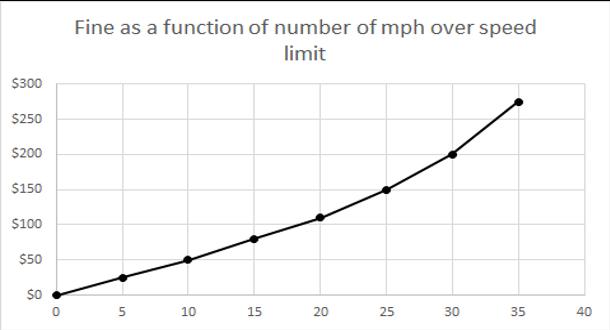Question
On most state highways, the fine for speeding depends on the speed of the car. In a certain state, suppose the fine as a function
On most state highways, the fine for speeding depends on the speed of the car. In a certain state, suppose the fine as a function of the number of miles per hour over the speed limit is f(n).f(n). The graph of this function is shown below.
 For each of the following situations, write a function, in terms of f(n), that describes the new fine function, and draw the new graph with an appropriate scale. Draw each graph separately.
For each of the following situations, write a function, in terms of f(n), that describes the new fine function, and draw the new graph with an appropriate scale. Draw each graph separately.
a) The state determines that the fine at every speed should go up by $5.
b) The state determines that the fines at every speed should be one and a half times the regular fine in construction zones.
c) The state decides to adjust all fines in such a way as to give an 8 mph “buffer”. (For example, the new fine for driving 30 mph over the speed limit will be the same as the current fine for driving 22 mph over the speed limit.)
Fine as a function of number of mph over speed limit $300 $250 $200 $150 $100 $50 So 10 15 20 25 30 35 40
Step by Step Solution
3.53 Rating (150 Votes )
There are 3 Steps involved in it
Step: 1
Was solved thi...
Get Instant Access to Expert-Tailored Solutions
See step-by-step solutions with expert insights and AI powered tools for academic success
Step: 2

Step: 3

Ace Your Homework with AI
Get the answers you need in no time with our AI-driven, step-by-step assistance
Get Started


